How To Change Background In Photoshop Cs5

The Background Layer In Photoshop CS5
Before we begin... This version of our Groundwork Layer tutorial is for Photoshop CS5 and earlier. If you're using Photoshop CS6, please see our updated Background Layer tutorial. For Photoshop CC, see our Groundwork Layer in Photoshop CC tutorial.
In the previous tutorial, we learned the essential skills for working with layers inside Photoshop's Layers panel. We learned how to add together new layers, delete layers, move layers above and below each other, how to add adjustment layers and layer styles, change a layer'southward blend fashion and transparency level, and much more than, all from within the Layers panel!
Only before we get into more of the amazing things we can do with layers, at that place's one special type of layer nosotros need to await at, and that's the Groundwork layer. The reason we need to learn about information technology is considering there's a few things nosotros can do with normal layers that we tin can't do with the Background layer, and if we're not aware of them ahead of time, they can easily lead to confusion and frustration.
Hither'due south an epitome of a photo frame that I've but opened in Photoshop. The image is available from the Fotolia paradigm library:
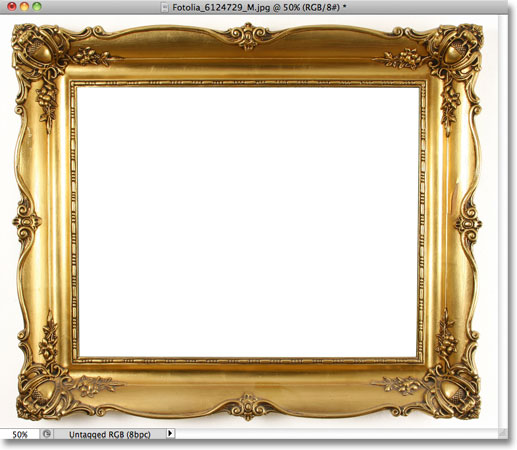
The original image.
Whenever we open up a new paradigm in Photoshop, it opens inside its own document and Photoshop places the image on its own layer named Background, equally we can see by looking in my Layers panel. Notice that the give-and-take Groundwork is written in italics, which is Photoshop'due south style of telling us there's something special about this particular layer:
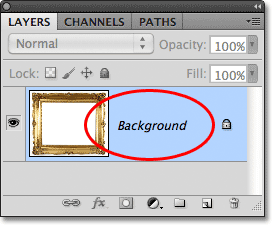
The Layers panel showing the epitome on the Background layer.
Photoshop names this layer Background for the simple reason that information technology serves as the background for our document. Any additional layers we add to the document will appear above the Background layer. Since its whole purpose is to serve every bit a background, there's a few things Photoshop won't let us to practise with information technology. Let's take a quick look at these few elementary rules we need to think. Then, at the end of the tutorial, we'll learn an like shooting fish in a barrel way to get around every single one of them!
Shortcodes, Deportment and Filters Plugin: Error in shortcode [ads-basics-middle-2]
Rule ane: We Can't Motility The Contents Of A Background Layer
I of the things we can't do with a Background layer is move its contents. Normally, to move the contents of a layer, we grab the Move Tool from the peak of the Tools panel:

Selecting the Movement Tool from the Tools console.
Then we simply click with the Motility Tool within the document and drag the contents around with our mouse. Watch what happens, though, when I attempt to drag the photo frame to a different location. Photoshop pops open a dialog box telling me information technology can't motion the contents because the layer is locked:
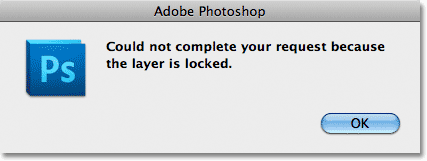
Instead of moving the photo frame, Photoshop informs me that the layer is locked.
If we expect once more at the Background layer in my Layers panel, we can run across a small lock icon, letting united states know that certain plenty, this layer is locked in identify and nosotros tin can't motility it. There's no style to unlock a Background layer, but as I said, at the end of the tutorial, we'll run across how to go around this piddling rule of not being able to move its contents, besides as how to become around the other rules nosotros're about to wait at:
The lock icon lets us know that some aspect of this layer is locked.
Rule 2: No Transparent Pixels
In a moment, I'yard going to import another image into my document and place it within my photo frame, but the center of the frame is currently filled with white, which means I need to delete that white area earlier I can place my photo inside of it. Normally, when we delete pixels on a layer, the deleted surface area becomes transparent, assuasive the states to see through information technology to the layer(s) beneath. Permit's see what happens, though, when I effort to delete something on the Background layer.
First, I need to select the area within the frame, and since information technology's filled with solid white, I'll employ the Magic Wand Tool. In Photoshop CS2 and earlier, nosotros can select the Magic Wand just by clicking on its icon in the Tools console. In Photoshop CS3 and college (I'chiliad using Photoshop CS5 here), the Magic Wand is hiding behind the Quick Selection Tool, so click on the Quick Pick Tool and hold your mouse button downwards for a second or ii until a wing-out menu appears showing the other tool(s) nested behind information technology, and then select the Magic Wand Tool from the list:
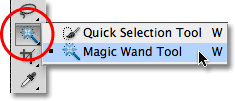
Selecting the Magic Wand Tool.
With the Magic Wand Tool in hand, I'll click anywhere inside the center of the frame to instantly select the entire white expanse. A selection outline appears around the edges letting me know the area is selected:
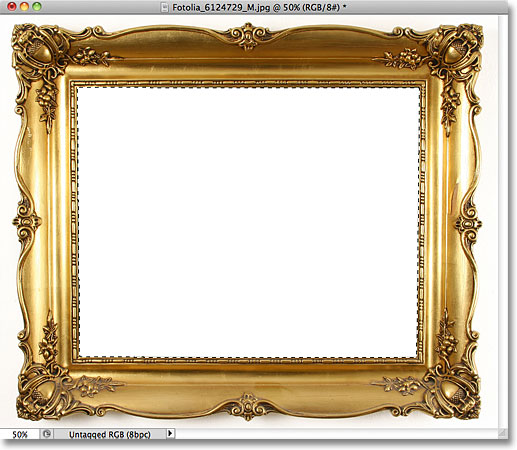
The white expanse inside the frame is now selected.
To delete the area within the frame, I'll printing Backspace (Win) / Delete (Mac) on my keyboard, but instead of deleting the surface area and replacing it with transparency as we'd expect on a normal layer, Photoshop mysteriously pops open the Fill dialog box so I tin choose a different color to fill the area with:
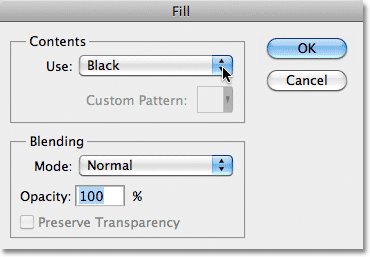
Instead of deleting the expanse, Photoshop pops open the Fill dialog box.
I'll click Cancel to close out of the Fill up dialog box since that wasn't at all what I wanted to exercise. What I wanted to practice was delete the white area inside the frame, not fill up it with a different colour. Maybe Photoshop just got confused, so I'll endeavor something different. I'll go up to the Edit menu in the Menu Bar forth the elevation of the screen and choose Cut:

Selecting Cut from the Edit menu.
On a normal layer, this would cut the selected area from the layer, leaving a transparent area in its identify, even so over again, we get an unexpected result. This fourth dimension, every bit if its purposely messing with me, Photoshop fills the area with black:
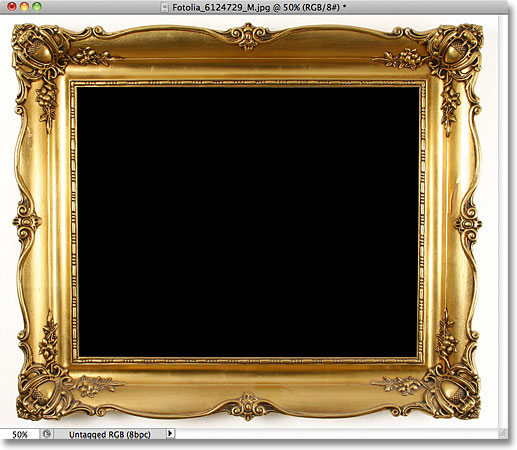
The white area inside the frame is now filled with blackness.
Say what? Where did the blackness come from? As it turns out, Photoshop filled the expanse with black considering if we wait at my Foreground and Background color swatches almost the lesser of the Tools panel, we see that my Background colour (the lower correct swatch) is currently set to black, and Photoshop filled the area with the Background color. If my Background color had been set to regal, it would take filled the area with purple. Information technology just happened to exist set to black:

The Foreground (upper left) and Background (lower right) color swatches.
So why won't Photoshop delete the white area within the frame? Why does information technology go on wanting to fill it with a unlike color instead? The reason is because Groundwork layers don't support transparency. After all, since the Background layer is supposed to be the groundwork of the certificate, there shouldn't exist any need to see through information technology considering at that place shouldn't exist anything behind it to run into. The background is, after all, the background! No affair how I try, I will never be able to delete the surface area within the center of the frame as long every bit the paradigm remains on the Background layer. How, then, will I be able to display another photo inside the frame? Let'southward leave this trouble solitary for the time beingness. We'll come dorsum to it a bit after.
Rule three: We Can't Move The Background Layer Above Another Layer
Here'southward the photo I want to identify inside my photo frame. This image is as well available from the Fotolia image library:
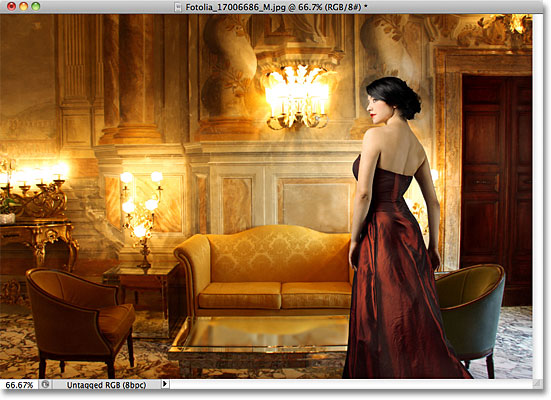
The epitome that will exist placed inside the frame.
The image is currently open within its own certificate window, and so I'll quickly copy it into the photo frame'southward document by pressing Ctrl+A (Win) / Command+A (Mac) to select the entire photograph, then I'll printing Ctrl+C (Win) / Command+C (Mac) to copy the epitome to the clipboard. I'll switch over to the photograph frame'due south document, and so I'll press Ctrl+V (Win) / Command+5 (Mac) to paste the prototype into the document. Photoshop places the epitome on a new layer named "Layer 1" higher up the photograph frame on the Background layer:
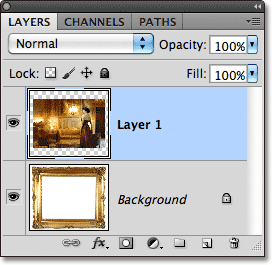
The second photo is placed on its own layer above the Background layer.
And we can see the new photo appearing in front end of the frame in the document window:
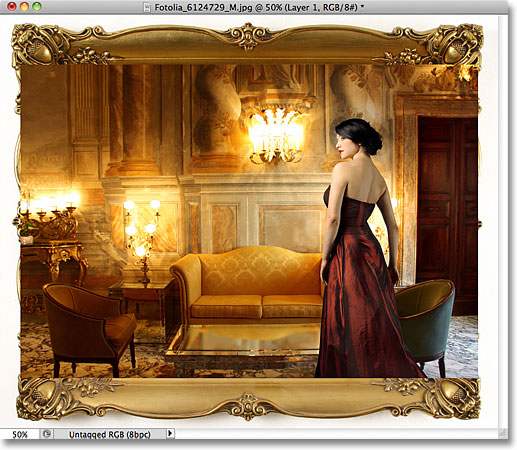
The second paradigm appears in forepart of the photo frame.
In order for my 2nd photo to announced inside the frame, I need to rearrange the order of the layers in the Layers console so that the frame appears above the photo. Ordinarily, moving one layer above another is every bit easy equally clicking on the layer we need to motion and dragging it to a higher place the other layer, just that's not the case when the layer we need to move is the Background layer. When I click on the Background layer and effort dragging information technology above the photo on Layer ane, Photoshop displays a circumvolve icon with a diagonal line through it (the international "non gonna happen" symbol), letting me know that for some reason, it's not going to let me do it:
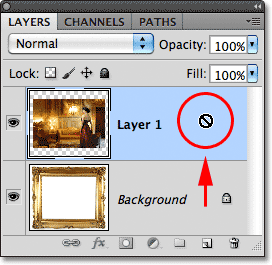
The circle with the diagonal line through information technology tells me I tin't drag the Groundwork layer above Layer 1.
The reason it won't let me drag the Groundwork layer above Layer one is because the Background layer must always remain the groundwork of the document. Photoshop won't let u.s.a. to move information technology above any other layers.
Rule 4: We Can't Move Other Layers Below The Background Layer
Okay, so we can't move the Background layer above another layer. What if we endeavor moving some other layer below the Background layer? I'll click on Layer 1 and endeavor to drag it below the Background layer, but this doesn't work either. I get the same piddling ghostbusters symbol telling me that Photoshop won't let me practise it:
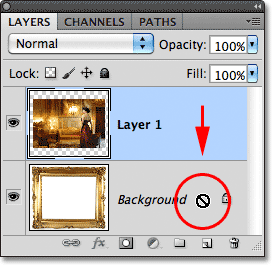
The aforementioned "not gonna happen" icon appears when trying to drag Layer 1 below the Background layer.
Again, the reason is because the Background layer must ever remain the background of the document. We can't drag information technology above other layers and we tin can't drag other layers below it.
The Easy Solution
Allow's speedily recap. We've learned that Photoshop won't let u.s.a. movement the contents of the Background layer with the Move Tool because the layer is locked in place. We learned that the Background layer doesn't support transparency, so there's no style to delete anything on the layer. And we learned that the Background layer must ever remain the bottom layer in the Layers panel. We can't elevate it above other layers, and we can't drag other layers below it.
Since the Background layer'southward whole purpose in life is to be the background of the document, each of these rules makes sense. Notwithstanding equally with most rules, there's ways around them for times when we need to pause them. In this case, there'southward an easy fashion around all of them at one time! All nosotros need to do is rename the Groundwork layer to something other than Background! To rename the Groundwork layer, you lot could go up to the Layer menu at the top of the screen, choose New, and then cull Layer From Groundwork:

Go to Layer > New > Layer From Groundwork.
A faster way, though, is to just double-click direct on the word Background in the Layers panel:
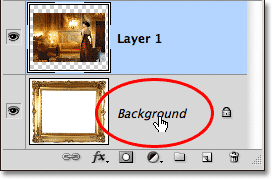
Double-click directly on the Background layer's name.
Either way opens the New Layer dialog box where nosotros can enter a new name for the layer. The default name of "Layer 0" works fine. Whatsoever name other than Background will work, so unless you have something specific you desire to name the layer, simply click OK to accept Layer 0 as the new name and close out of the dialog box:

You tin accept Layer 0 equally the new name for the layer or enter a different name if you prefer.
TIP: For an fifty-fifty faster way to rename the Background layer, simply concord down your Alt (Win) / Choice (Mac) key and double-click on the give-and-take Groundwork. Photoshop volition instantly rename the layer "Layer 0", bypassing the New Layer dialog box completely.
We can now run across that the name of the Background layer has been inverse to Layer 0:
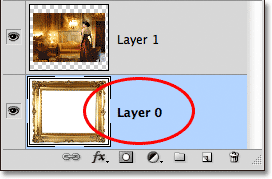
The Background layer has been renamed Layer 0.
And only by renaming information technology, we've converted the Groundwork layer into a normal layer, which means we're no longer jump by any of the rules we just looked at! We can move the contents of the layer with the Move Tool, we can delete anything on the layer and replace it with transparency, and we can freely move the layer above or below other layers!
For instance, I still need to motion my photo frame in a higher place the image on Layer 1. Now that the frame is no longer on the Background layer, it's piece of cake! I can just click on Layer 0 in the Layers panel and drag it upward until a thin highlight bar appears above Layer 1:
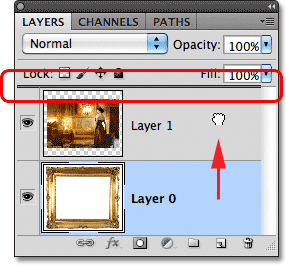
Dragging Layer 0 higher up Layer 1.
I'll release my mouse push button, and Photoshop drops Layer 0 in a higher place Layer 1, exactly equally I needed:
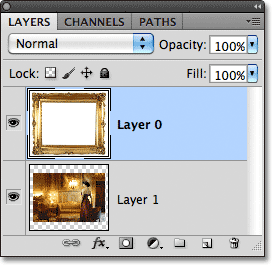
Layer 0 now appears in a higher place Layer one, which would non accept been possible while Layer 0 was still the Background layer.
We saw earlier that I was unable to delete the white area inside the frame while the image was on the Background layer, only at present that I've renamed it to Layer 0, it's no longer a problem. I'll click inside the expanse with the Magic Wand Tool to instantly select it, just as I did before:

The white expanse inside the frame is once once more selected.
Then, I'll press Backspace (Win) / Delete (Mac) on my keyboard, and this fourth dimension, instead of beingness greeted past the Make full dialog box, Photoshop actually does what I expected, deleting the area from the layer and revealing the photo behind it:
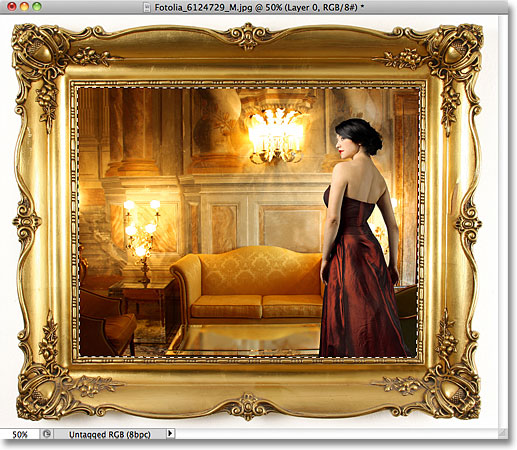
The area inside the frame has finally been deleted, revealing the photo underneath.
I'll press Ctrl+D (Win) / Command+D (Mac) on my keyboard to deselect the area inside the frame and remove the selection outline. And so, just to quickly end things off, I'll click on Layer 1 in the Layers console to select information technology and brand it the active layer:
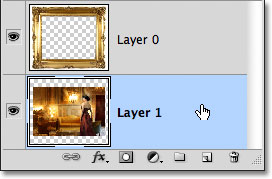
Selecting Layer 1.
I'll grab the Movement Tool from the Tools console, click on the photograph and drag information technology into position inside the frame. Even though Layer 1 is now the bottom layer in the document, it's not an actual Groundwork layer so information technology'south non locked in place. I'm free to move it anywhere I want:
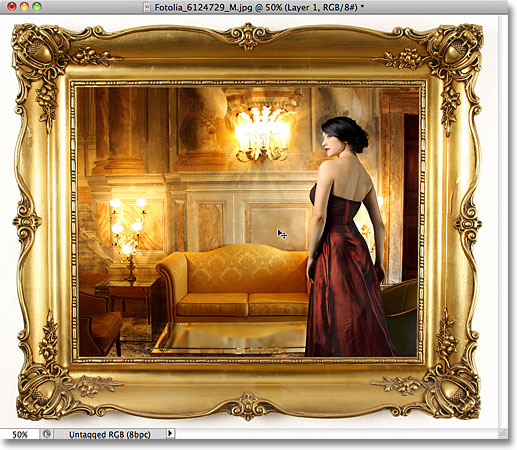
Dragging the photo into position inside the frame.
As we've seen, Background layers are special types of layers in Photoshop with certain limitations placed on them. Nosotros can't movement their contents, we can't delete anything on them, and they e'er take to remain the bottom layer in the document. In most cases, these limitations are of piffling concern to us because we generally don't work directly on the Groundwork layer anyway. Merely if you practice need to override them, merely rename the Groundwork layer to anything other than Background, which will instantly catechumen information technology to a normal layer, and yous're good to become!
Other Stuff
© 2022 Photoshop Essentials.com.
For inspiration, not duplication.
Site design by Steve Patterson.
Photoshop is a trademark of Adobe Systems Inc.
Source: https://www.photoshopessentials.com/basics/photoshop-background-layer/
Posted by: franklinimmill.blogspot.com


0 Response to "How To Change Background In Photoshop Cs5"
Post a Comment